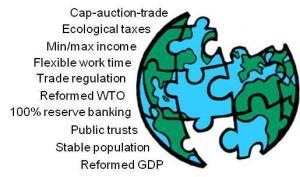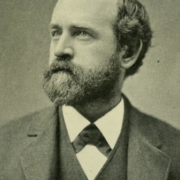Top 10 Policies for a Steady State Economy
by Herman Daly
Let’s get specific. Here are ten policies for ending uneconomic growth and moving to a steady state economy. A steady state economy is one that develops qualitatively (by improvement in science, technology, and ethics) without growing quantitatively in physical dimensions; it lives on a diet—a constant metabolic flow of resources from depletion to pollution (the entropic throughput) maintained at a level that is both sufficient for a good life and within the assimilative and regenerative capacities of the containing ecosystem.
Ten is an arbitrary number—just a way to get specific and challenge others to suggest improvements. Although the whole package here discussed fits together in the sense that some policies supplement and balance others, most of them could be adopted singly and gradually.
1. Cap-auction-trade systems for basic resources.
Caps limit biophysical scale by quotas on depletion or pollution, whichever is more limiting. Auctioning the quotas captures scarcity rents for equitable redistribution. Trade allows efficient allocation to the highest uses. This policy has the advantage of transparency. There is a limit to the amount and rate of depletion and pollution that the economy can be allowed to impose on the ecosystem. Caps are physical quotas, limits to the throughput of basic resources, especially fossil fuels. The quota usually should be applied at the input end because depletion is more spatially concentrated than pollution and hence easier to monitor. Also, the higher price of basic resources will induce their more economical use at each upstream stage of production, as well as at the final stages of consumption and recycling. Ownership of the quotas is initially public—the government periodically auctions them to individuals and firms. There should be no “grandfathering” of quota rights to previous users or “offshoring” of quotas for new fossil fuel power plants in one by place by credits from planting trees somewhere else. Reforestation is a good policy on its own. It is too late for self-canceling half measures—increased carbon sequestration and decreased emissions are both needed. The auction revenues go to the treasury and are used to replace regressive taxes, such as the payroll tax, and to reduce income tax on the lowest incomes. Once purchased at auction the quotas can be freely bought and sold by third parties, just as can the resources whose rate of depletion they limit. The cap serves the goal of a sustainable scale; the auction serves the goal of fair distribution; and trading allows efficient allocation—three goals, three policy instruments. Although mainly applied to nonrenewable resources, the same logic works for limiting the off-take from renewable resources, such as fisheries and forests, with the quota level set to approximate a sustainable yield.

A shift in the tax base from value added to the entropic throughput of resources extracted from nature and returned to nature would be efficient and equitable. (Image: CC0, Credit: Flickr).
2. Ecological tax reform.
Shift the tax base from value added (labor and capital) to “that to which value is added,” namely the entropic throughput of resources extracted from nature (depletion) and returned to nature (pollution). Such a tax shift prices the scarce but previously un-priced contribution of nature. Value-added to natural resources by labor and capital is something we want to encourage, so stop taxing it. Depletion and pollution are things we want to discourage, so tax them. Payment above necessary supply price is rent, unearned income, and most economists have long advocated taxing it, both for efficiency and equity reasons. Ecological tax reform can be an alternative or a supplement to cap-auction-trade systems.
3. Limit the range of inequality in income distribution with a minimum income and a maximum income.
Without aggregate growth poverty reduction requires redistribution. Unlimited inequality is unfair; complete equality is also unfair. Seek fair limits to the range of inequality. The civil service, the military, and the university manage a range of inequality of a factor of fifteen or 20. Corporate America has a range of 500 or more. Many industrial nations are below 25. Could we not limit the range to, say, 100, and see how it works? This might mean a minimum of 20 thousand dollars and a maximum of 2 million. Is that not more than enough to give incentive for hard work and compensate for real differences? People who have reached the limit could either work for nothing at the margin if they enjoy their work, or devote their extra time to hobbies or public service. The demand left unmet by those at the top will be filled by those who are below the maximum. A sense of community, necessary for democracy, is hard to maintain across the vast income differences current in the United States. Rich and poor separated by a factor of 500 have few experiences or interests in common and are increasingly likely to engage in violent conflict.
4. Free up the length of the working day, week, and year—allow greater options for part-time or personal work.
Full-time external employment for all is hard to provide without growth. Other industrial countries have much longer vacations and maternity leaves than the United States. For the classical economists, the length of the working day was a key variable by which the worker (self-employed yeoman or artisan) balanced the marginal disutility of labor with the marginal utility of income and of leisure so as to maximize the enjoyment of life. Under industrialism, the length of the working day became a parameter rather than a variable (and for Karl Marx was the key determinant of the rate of exploitation). We need to make it more of a variable subject to choice by the worker. Milton Friedman wanted “freedom to choose”—OK, here is an important choice most of us are not allowed to make! And we should stop biasing the labor-leisure choice by advertising to stimulate more consumption and more labor to pay for it. At a minimum advertising should no longer be treated as a tax-deductible expense of production.
5. Re-regulate international commerce—move away from free trade, free capital mobility, and globalization.
Cap-auction-trade, ecological tax reform, and other national measures that internalize environmental costs will raise prices and put us at a competitive disadvantage in international trade with countries that do not internalize costs. We should adopt compensating tariffs to protect, not inefficient firms, but efficient national policies of cost internalization from standards-lowering competition with foreign firms that are not required to pay the social and environmental costs they inflict. This “new protectionism” is very different from the “old protectionism” that was designed to protect a truly inefficient domestic firm from a more efficient foreign firm. The first rule of efficiency is “count all the costs”—not “free trade,” which coupled with free capital mobility leads to a standards-lowering competition to count as few costs as possible. Tariffs are also a good source of public revenue. This will run afoul of the World Trade Organization/World Bank/International Monetary Fund, so. . .
6. Downgrade the WTO/WB/IMF.
Reform these organizations based on something like Keynes‘ original plan for multilateral payments clearing union, charging penalty rates on surplus as well as deficit balances with the union—seek balance on the current account, and thereby avoid large foreign debts and capital account transfers. For example, under Keynes’ plan, the USA would pay a penalty charge to the clearing union for its large deficit with the rest of the world, and China would also pay a similar penalty for its surplus. Both sides of the imbalance would be pressured to balance their current accounts by financial penalties, and if need be by exchange rate adjustments relative to the clearing account unit, called the “bancor” by Keynes. The bancor would also serve as the world reserve currency, a privilege that should not be enjoyed by any national currency, including the U.S. dollar. Reserve currency status for the dollar is a benefit to the USA—rather like a truckload of free heroin is a benefit to an addict. The bancor would be like gold under the gold standard, only you would not have to tear up the earth to dig it out. Alternatively, a regime of freely fluctuating exchange rates is a viable possibility requiring less international cooperation.
7. Move away from fractional reserve banking toward a system of 100 percent reserve requirements.
This would put control of the money supply and seigniorage (profit made by the issuer of fiat money) in the hands of the government rather than private banks, which would no longer be able to live the alchemist’s dream by creating money out of nothing and lending it at interest. All quasi-bank financial institutions should be brought under this rule, regulated as commercial banks subject to 100 percent reserve requirements. Banks would earn their profit by financial intermediation only, lending savers’ money for them (charging a loan rate higher than the rate paid to savings or “time-account” depositors) and charging for checking, safekeeping, and other services. With 100 percent reserves, every dollar loaned to a borrower would be a dollar previously saved by a depositor (and not available to him during the period of the loan), thereby re-establishing the classical balance between abstinence and investment. With credit limited by prior saving (abstinence from consumption), there will be less lending and borrowing and it will be done more carefully—no more easy credit to finance the massive purchase of “assets” that are nothing but bets on dodgy debts. To make up for the decline in bank-created, interest-bearing money the government can pay some of its expenses by issuing more non-interest-bearing fiat money. However, it can only do this up to a strict limit imposed by inflation. If the government issues more money than the public voluntarily wants to hold, the public will trade it for goods, driving the price level up. As soon as the price index begins to rise the government must print less and tax more. Thus a policy of maintaining a constant price index would govern the internal value of the dollar. The Treasury would replace the Federal Reserve, and the target policy variables would be the money supply and the price index, not the interest rate. The external value of the dollar could be left to freely fluctuating exchange rates (or preferably to the rate against the bancor in Keynes’ clearing union).
8. Stop treating the scarce as if it were free and the free as if it were scarce.
Enclose the remaining open-access commons of rival natural capital (e.g., the atmosphere, the electromagnetic spectrum, and public lands) in public trusts, and price them by cap-auction-trade systems, or by taxes. At the same time, free from private enclosure and prices the non-rival commonwealth of knowledge and information. Knowledge, unlike the resource throughput, is not divided in the sharing, but multiplied. Once knowledge exists, the opportunity cost of sharing it is zero, and its allocative price should be zero. International development aid should more and more take the form of freely and actively shared knowledge, along with small grants, and less and less the form of large interest-bearing loans. Sharing knowledge costs little, does not create un-repayable debts, and increases the productivity of the truly rival and scarce factors of production. Patent monopolies (aka “intellectual property rights”) should be given for fewer “inventions” and for fewer years. Costs of production of new knowledge should, more and more, be publicly financed and then the knowledge freely shared. Knowledge is a cumulative social product, and we have the discovery of the laws of thermodynamics, the double helix, polio vaccine, etc. without patent monopolies and royalties.
9. Stabilize population.
Work toward a balance in which births plus in-migrants equals deaths plus out-migrants. This is controversial and difficult, but as a start contraception should be made available for voluntary use everywhere. And while each nation can debate whether it should accept many or few immigrants, and who should get priority, such a debate is rendered moot if immigration laws are not enforced. We should support voluntary family planning and enforcement of reasonable immigration laws, democratically enacted.
10. Reform national accounts—separate GDP into a cost account and a benefits account.
Natural capital consumption and “regrettably necessary defensive expenditures” belong in the cost account. Compare costs and benefits of a growing throughput at the margin and stop throughput growth when marginal costs equal marginal benefits. In addition to this objective approach, recognize the importance of the subjective studies that show that, beyond a threshold, further GDP growth does not increase self-evaluated happiness. Beyond a level already reached in many countries, GDP growth delivers no more happiness but continues to generate depletion and pollution. At a minimum, we must not just assume that GDP growth is economic growth, but prove that it is not uneconomic growth.
Currently, these policies are beyond the pale politically. To the reader who has persevered this far, I thank you for your willing suspension of political disbelief. Only after a significant crash, a painful empirical demonstration of the failure of the growth economy, would this ten-fold program, or anything like it, stand a chance of being enacted.

Sharing knowledge poses several benefits such as un-repayable debts, fewer costs, and increases productivity. (Image: CC0, Credit: pxfuel).
To be sure, the conceptual change in vision from the norm of a growth economy to that of a steady state economy is radical. Some of these proposals are rather technical and require more explanation and study. There is no escape from studying economics, even if, as Joan Robinson said, the main reason for it is to avoid being deceived by economists. Nevertheless, the policies required are far from revolutionary and are subject to gradual application. For example, 100 percent reserve banking was advocated in the 1930s by the conservative Chicago School and can be approached gradually, the range of distributive inequality can be restricted gradually, caps can be adjusted gradually, etc. More importantly, these measures are based on the impeccably conservative institutions of private property and decentralized market allocation. The policies here advocated simply reaffirm forgotten pillars of those institutions, namely that: (1) Private property loses its legitimacy if too unequally distributed, (2) markets lose their legitimacy if prices do not tell the truth about opportunity costs, and as we have more recently learned; (3) the macro-economy becomes an absurdity if its scale is required to grow beyond the biophysical limits of the earth.
Well before reaching that radical biophysical limit, we are encountering the classical economic limit in which extra costs of growth become greater than the extra benefits, ushering in the era of uneconomic growth, whose very possibility is denied by the growthists. The inequality of wealth distribution has canceled out the traditional virtues of private property by bestowing nearly all benefits of growth to the top one percent, while generously sharing the costs of growth with the poor. Gross inequality, plus monopolies, subsidies, tax loopholes, false accounting, cost-externalizing globalization, and financial fraud have made market prices nearly meaningless as measures of opportunity cost. For example, a policy of near zero interest rates (quantitative easing) to push growth and bail out big banks has eliminated the interest rate as a measure of the opportunity cost of capital, thereby crippling the efficiency of investment. Trying to maintain the present growth-based Ponzi system is far more unrealistic than moving to a steady state economy by something like the policies here outlined. It is probably too late to avoid unrealism’s inevitable consequences. But while we are hunkered down and unemployed, enduring the crash, we might think about the principles that should guide reconstruction.
 Herman Daly is CASSE Chief Economist, Professor Emeritus (University of Maryland), and past World Bank senior economist.
Herman Daly is CASSE Chief Economist, Professor Emeritus (University of Maryland), and past World Bank senior economist.








Daly writes under POLICY 1. Cap-auction-trade systems for basic resources. Caps limit biophysical scale by quotas on depletion or pollution, whichever is more limiting.
I AGREE — however we must choose “depletion” or “pollution” that is real and significant.
Daly goes on to say ” It is too late for self-canceling half measures — increased carbon sequestration and decreased emissions are both needed.” ————showing that he is a captive of the ‘group think’ spearheaded by the IPCC that doggedly insists CURRENT carbon containing greenhouse gas emissions are primary regulators of the global climate // while refusing to involve scientists that make an excellent case for the solar variation as the primary regulator of the global climate regulator.
The following material offers a sobering look at the conventional, myopic, IPCC-led view about climate policy:
Topher Fields explains — in the introductory 10 minute video for the 50:1 project — how adapting to climate change is vastly less expensive than attempting to stop climate change ————– even if we accept the projections of climate models for FUTURE climate warming that are based on the mistaken assumption that carbon containing greenhouse gases are actually the primary regulators of the global climate —- see:
http://topher.com.au/50-to-1-video-project/
This same URL http://topher.com.au/50-to-1-video-project/ will lead you to all of the interviews that Topher Fields produced with people who reasonably reject the ‘catastrophic human caused climate change hypothesis’ . I recommend those with Fred Singer, David Evans, Anthony Watts, Joanne Nova and Donna Laframboise, each of which runs +/- one hour —- for those people who can afford the time to get a firm handle on the irresponsible pronouncements of the climate alarmists during the last 35 or so years.
Peter Salonius
OK. So which global dictator shall we empower to implement all of this? Oh, wait, that will never happen. Guess it will be business as usual until we run out of steam and crash. Feast and famine, as usual. Oh, well, nice try, but what a wast of time. See you on the front lines of WW3.
I think a key control factor is missing from this list. It is the control of productivity.
If productivity increases faster than the economy, and technologies allow for further increases in the future, then the economy will go into a deflationary death spiral as there is less money in the workforce, causing reduced economic activity forcing greater productivity, … Under the current system, the only way to way out of this, is to increase the economy at least as fast as increasing productivity.
The only way to correct this downward spiral of increased productivity-reduced economic activity-increased productivity-… (without destroying the planet) is to change the structure of how work is paid for. As long as labor is everyone’s expense, it will always be in everyone’ interest to reduce that expense. e.g., all other things being equal, I will choose the product/service that costs less – which often means lower labor costs (total wage costs).
I think the only thing that will work is for the price of goods and services to go DOWN when labor costs go up. That way, the product/service that costs less will be the one that employs more people. There are probably many ways to make this happen, but one way would be to provide a “dowery” for each worker, say to pay for business’ medical insurance costs or training costs, or just the 1st $5/hr of wages. It’s possible this dowery could be collected by your cap-auction-trade system.
A direct and politically controlled tax on energy inputs will be much more effective than the bureaucratic nightmare of cap and trade. Such a tax will be offset dollar for dollar against income tax or labor tax and benefits those who pay the highest percentage tax rate.
Progressive taxation has yielded to political power of corporatists yet remains far superior to nebulous theories about limiting income, unless, I’m in charge of the bureaucracy doing the limiting.
See “balancing inequality” on youtube if you really want the answer. Capping what you can inherit would neuter excessive greed, and reward contribution to your species instead of encouraging it’s destruction! Thanks for seeking sustainability for the future. Watch and share “balancing inequality” on youtube! An IHERITANCE CAP!
I think your limit of “the range of inequality of wage distribution” is not going far enough. !0 should be the maximum factor. If someone cannot be motivated by a factor of 10 incress then let them join the lower ranks of society. No person is capable of working 100 times harder than another.
Excuse me I meant 10 not “!0” in the second sentence of my comment.
Hemp production would alow everyone to prosper! My foundation would give people $200,000for every child to adopt paying for the child’s living expenses for 18 years the stipulation would be the family would have to start a sustainable business and give 10% back to the fund this would help control the population.
Implement a sustainability quotient (SQ) in all projects. SQ will range from 0 to 1. It will be a measure of the long term environmental cost determined by an independent body.
Project-cost (without including environmental cost) divided by SQ = Real Project Cost
SQ will determine the long term cost of environmental impact. Then you will know the real cost of GMOs, mining, nuclear power and fossil fuel based energy generation.
Renewable energy generation will have an SQ very close to 1 while fossil fuel based energy generation will have an SQ closer to zero so the real cost of renewable energy will go down while cost of non-renewable (fossil fuel) based energy will go up.
I appreciate the goals (though I don’t think steady rates of resource wasting are any more sustainable – better to just stop waste). I was wondering how this list shapes up without the bit that has blocked such things politically for decades, ie the give-up-on-economic-growth bit. Seems to me that a version of this list (perhaps a more ambitious version) would be compatible with GDP growth. Such policies (such as correcting externalities and reinvesting the correction, creating money supply without debt and austerity, and recirculating extreme wealth that otherwise clots up) would actually be a growth bonanza.
Is the no-GDP-growth bit so important (that you’d rather watch the world go down the pan) or could we rethink it if it meant all your other goals became quickly achievable?
nice post
There should be no “grandfathering” of quota rights to previous users or “offshoring” of quotas for new fossil fuel power plants in one by place by credits from planting trees somewhere else. Reforestation is a good policy on its own. It is too late for self-canceling half measures—increased carbon sequestration and decreased emissions are both needed. The auction revenues go to the treasury and are used to replace regressive taxes, such as the payroll tax, and to reduce income tax on the lowest incomes. Once purchased at auction the quotas can be freely bought and sold by third parties, just as can the resources whose rate of depletion they limit. The cap serves the goal of a sustainable scale; the auction serves the goal of fair distribution; and trading allows efficient allocation—three goals, three policy instruments. Although mainly applied to nonrenewable resources, the same logic works for limiting the off-take from renewable resources, such as fisheries and forests, with the quota level set to approximate a sustainable yield